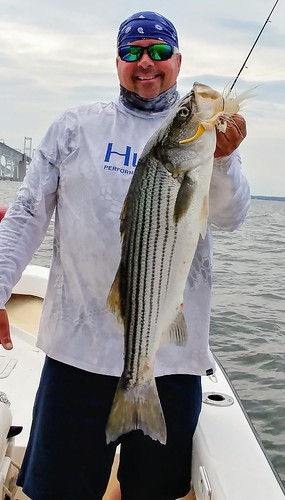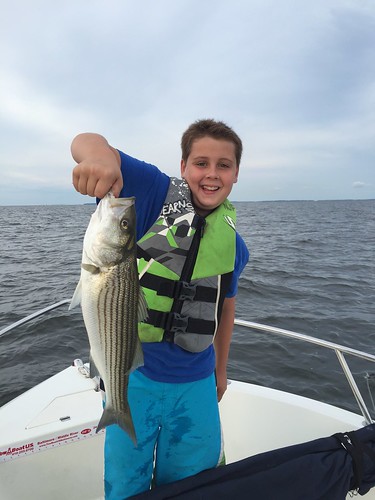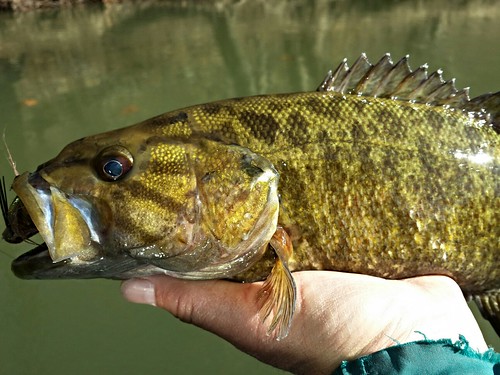Maryland Fishing Report: June 20
Fishing offers many things to many people, and they all have their own reasons why it’s so special.
For some it’s an adventurous location or pursuit of a certain fish, usually preceded by a lot of study and anticipation before the big trip. For others it may be the unwinding process from a stressful day.
One thing many anglers get particular joy out of is sharing the experience with others – often the sign of a true sportsman is when they involve first-time anglers or children.
That’s why in these fishing reports we like to show our fishing community holding large, admirable fish, to inspire us all and to highlight the bounty we have available to us here in Maryland.
Don’t forget there is one more free fishing day coming up July 4. If you can think of someone you might like to introduce to fishing, this is a great opportunity for someone to try the sport without buying a license.
Weekly Fishing Conditions Forecast Summary: June 20-26
As we enjoy the first day of summer June 21, the recent rainfall continues to impact state waters, with above-average flows reducing surface salinities and clarity in many areas of the upper bay. Besides some rain Friday and Saturday, anglers will experience warm, sunny fishing conditions for most of the upcoming week.
Recent warm and sunny conditions have pushed main bay water temperatures to 78 degrees, and will continue to push them toward the low 80s. These warmer temperatures will result in rockfish seeking cooler, deeper waters with adequate oxygen levels. Areas from Gunpowder Neck and Swan Point south to the Bay Bridge are showing poor bottom oxygen conditions below about 13 to 16 feet. However, other portions of the main bay and tidal rivers have much better oxygen conditions so be sure to check the full forecast and the Don’t Fish Below this Depth for conditions in your area.
There will be above average tidal currents Saturday through Tuesday as a result of the full moon June 28.
For the full weekly fishing conditions summary and more detailed and up-to-date fishing conditions in your area of the bay, be sure to check out Click Before You Cast.
Upper Chesapeake Bay
Fishing for striped bass this week remains good in the upper bay from the lower Susquehanna River to the Bay Bridge. There is good fishing around the Susquehanna Flats and lower part of the river, where live-lining white perch or drifting fresh cut baits is very effective. It’s important to keep in mind that the Conowingo Dam is releasing a lot of water during midday to evening power generation cycles.
Down at the areas of Rock Hall, Baltimore and south, chumming is the most popular way to fish. Swan Point, Love Point, the various knolls and shoal areas east of Baltimore Harbor as well as south of Podickory Point are all good places to look for striped bass. Many anglers are reporting they are finding fish in shallower waters at these sites. Some have also been chumming and chunking near the Francis Scott Key Bridge with good success. Salinity content is down due to excessive runoff, and catfish will be picking up baits resting on the bottom.

Rich Watts holds up a nice striped bass he caught at the Bay Bridge piers recently. Photo courtesy of Rich Watts
The sewer pipe and Bay Bridge piers have been good places to jig when the tide is running. The rock piles have also been holding fish. Most are using soft plastic jigs and working the bases of the piers. Angler Rich Watts recently decided to take a step back in time and use the old tried-and-true combination of a bucktail dressed with pork rind – a throwback to a practice common from 1940s to the late 1980s. It was durable stuff and would even tough it out with toothy bluefish.
Trolling has been an effective way to fish for striped bass on the eastern side of the upper bay where clarity is a little better. Gold spoons have been a favorite as have umbrella rigs. Casting a mix of topwater lures, swimshads and crankbaits has been providing some fun action in the Baltimore Harbor and Eastern Neck Island areas.
Water temperatures are creeping up into the upper 70s this week and salinities are low due to runoff. Chumming and chunking for striped bass at the outside edge of Hacketts Bar in about 20 feet of water has been good and any channel edge where suspended fish can be found with depth finders. The Hill, Tolly Bar, Thomas Point, Diamonds and the area off Chesapeake Beach are a few other locations worth checking. An ebb tide is reported to be the best and allowing larger baits to rest on the bottom at the back of the chum slick is accounting for some larger fish.
Jigging has been popular in many locations where fish are suspended. Steep channel edges and prominent points are good places to check out and reports have fish holding shallower than a few weeks ago. Kent Narrows has been a popular place to jig while drifting in a boat or casting from the bulkheads. Most are using jig heads just heavy enough to get to the bottom with dark colored soft plastics. Live-lining white perch and spot has also been a good way to fish for a better grade of striped bass.
Trolling is another option and most are pulling gold spoons or umbrella rigs along the edges of main channels, ballast stone piles and lumps. The channel edge from Chesapeake Beach south past Parkers Creek has been a good place to troll as well as the edge on the eastern side of the bay from Bloody Point south to the CR Buoy.
The shallow-water striped bass fishery is providing fun light-tackle fishing in the mornings and evenings when a good tide is running. Topwater lures have been the preferred way of fishing due to thick grass in the shallows.
As the lower bay region settles into summer, there are some questions and conversation around the docks about the future of striped bass fishing and whether recent patterns of fish moving toward northern regions of the bay occur again this year. Time will tell. At present chumming is one of the more popular ways to fish for striped bass in the lower Potomac River and the steep channel edge along St. George Island to Piney Point and out at the mouth of the river. The channel edge at Buoy 70 and 72 and the rock piles north of Point Lookout and at Point No Point. Many of the striped bass being caught are less than 19 inches, but larger fish are in the mix.

Photo by John Pirchio
Trolling offers a good option to catch a better grade of striped bass along channel edges in the bay and the lower Patuxent and Potomac rivers. Small to medium gold spoons have been a favorite as have swimshads or bucktails in tandem or behind umbrella rigs.
Jigging along the same areas where chumming and trolling are occurring continues to provide action. The lower Patuxent River channel edges as well as those in the lower Potomac and wherever fish can be found suspended along bay channels. Soft plastic jigs have been popular and some anglers are going to larger soft plastics in the 6-inch to 8-inch size range targeting larger fish.
The shallower water striped bass fishery offers some fun fishing opportunities during morning and evening hours. Grassy shallows, marsh edges and stump fields are great places to target with topwater lures or swimshads. Most of the striped bass being found there are small but offer some entertainment. On the eastern side of the bay speckled trout can also be part of the mix.
Fishing for croakers has been fair to good, along with a healthy portion of white perch, in the lower Patuxent River, Pocomoke Sound and Tangier Sound. Most of the croakers being caught are from the 2012 and 2013 year classes and medium-sized. Croakers have drifted back to modest numbers since about 2008 or so due to troubled larvae survival. Maryland’s portion of the Chesapeake Bay is the northern edge of their preferred range so when croaker populations are reduced, fewer make the trek to our waters. These fish population patterns are cyclical in nature and common among other species.
White perch fishing has been very good in all regions of the bay and tidal rivers. Bottom rigs baited with bloodworms or grass shrimp are a good choice in deeper waters and small jigs, small spinnerbaits and spinners are great choices for shallower fishing around structure. Shoreline rocks, fallen treetops, docks and bulkheads are all great places to fish with small lures and ultra-light tackle. White perch fishing is a great diversion from fishing for striped bass and we are fortunate this year to have a couple of strong year classes of white perch in the 11-inch to 13-inch size range.
Recreational crabbing is showing some marked improvement in the past week, and if crabs are on your mind it is definitely worth getting out to catch a half-bushel or better. The price of crabs soared over the Father’s Day Weekend to $300 a bushel or more. The lower bay region along the Eastern Shore is offering the best crabbing; the middle bay region is fair to good and the upper bay is fair at best. Salinities are depressed in the tidal rivers, so the best crabbing is near the mouths of the tidal rivers and creeks. As a result of excessive runoff and hot, sunny weather algae blooms are occurring and there may be depressed oxygen levels in waters deeper than 10 feet.
At Deep Creek Lake, fishing for smallmouth and largemouth bass has settled into a typical summer mode of fishing. The bass are most active in the early morning hours, which is the best time to be out on the lake due to boat traffic later on in the day. The evenings offer good shallow water fishing also. Main lake points, grass bed edges, and structure are good places to target with topwater lures, jerkbaits, buzzbaits and spinnerbaits. Later in the day the bass are looking for shade under fallen treetops and floating docks. Pitching grubs and tubes under the docks or near sunken wood is a good tactic. Trout are holding deep near the dam face, walleye are deep along steep edges and bluegills are holding in 8 to 10 feet of water near docks.
The delayed harvest trout management waters are now opened to creel limits of five fish per day through Sept. 30. Other trout management waters offer fun catch-and-release fishing this week. Various aquatic insect hatches are occurring and fly fishing with dry flies or other flies such as an elk hair caddis are fun ways to fish.
The upper Potomac is still running strong and boaters and waders should be very careful. Smallmouth bass are being caught on tubes, crankbaits and small topwater lures. Walleye can be caught at dusk to dark on crankbaits and tubes. Catfish are also very active in the evening hours.

Smallmouth bass
Many of the tidal rivers are showing water temperatures in the middle 70s now and largemouth bass are holding to a summer pattern of behavior. It is a bit tough to be out on the water at 5 a.m. this time of the year, with greatest length of daylight peaking on the first official day of summer. The early morning bite usually offers the best shallow-water action. Topwater lures such as poppers and buzzbaits cast into shallow grass is an exciting way to fish. If you can time it right, a falling tide early in the morning will cause largemouth bass to move out of grass beds and spatterdock fields and cruise the edges looking for bait fish doing the same. Spinnerbaits, jerkbaits and small lipless crankbaits are good lures to cast along these edges.
During the bright daylight hours, largemouth bass will be holding under thick grass or under the shade of docks and brush. Stick worms and soft plastic are a good bet at these locations. Casting topwater lures near grass in the tidal rivers can also elicit strikes from northern snakeheads when fishing near grass.
Another topwater target that often is overlooked is fly-fishing for bluegills with small rubber-legged poppers. Any budding fly-fishing enthusiast can break out a 4 or 5 weight fly rod with a floating line and have a ball enticing these little power houses to smack a popper cast near lily pads on a local pond.
Surf fishermen using bottom rigs baited with pieces of bloodworm or small strips of cut bait are enjoying some wonderful fishing for kingfish this week. A few large striped bass are being caught on larger cut baits along with a few bluefish. Sheepshead are beginning to show up at the South Jetty and they are being caught on sand fleas. Flounder are being caught in the inlet and larger striped bass and bluefish at times in the evening hours on bucktails, swim shads or by drifting fresh cut bait or live eels.
Flounder fishing in the back bay areas has been very good this week, most likely due to sparkling clear and warm water. Squid, minnows are the classic baits being used but Gulp baits are catching the largest flounder. A falling tide tends to offer the best action.
Outside the inlet, sea bass are being caught at various wreck and reef sites and it seems the farther and deeper one goes the better the sea bass fishing. Deep drop anglers are catching some very large sea bass and blueline tilefish.
Trolling for a mix of yellowfin tuna, bigeye tuna, Bluefin tuna and dolphin has been very good at the canyons this week. Some boats have been catching limits of yellowfin tuna, which tend to be on the small side. There are still mako and thresher sharks moving along the 30-40 fathom line locations and fresh skipjack fillets has been one of the better baits to use.
“There is nothing clinical about fishing…there is nothing about it that can be viewed in a clinical vacuum. Everything — as in everything else — relates to everything else; and the deeper down one goes, the nearer the quick of life one draws.” — Brian Clarke, 1975
 ABOUT THE AUTHOR Keith Lockwood has been writing the Fishing Report since 2003 and has had a long career as a fisheries research biologist since 1973. Over the course of his career he has studied estuarine fishery populations, ocean species, and over a decade long study of bioaccumulation of chemicals in aquatic species in New Jersey. Upon moving to Oxford on the eastern shore of Maryland; research endeavors focused on a variety of catch-and-release studies as well as other fisheries related research at the Cooperative Oxford Laboratory. Education and outreach to the fishing public has always been an important component to the mission of these studies. Keith is an avid outdoorsman enjoying hunting, fishing, bird dogs, family and life on the eastern shore of Maryland.
ABOUT THE AUTHOR Keith Lockwood has been writing the Fishing Report since 2003 and has had a long career as a fisheries research biologist since 1973. Over the course of his career he has studied estuarine fishery populations, ocean species, and over a decade long study of bioaccumulation of chemicals in aquatic species in New Jersey. Upon moving to Oxford on the eastern shore of Maryland; research endeavors focused on a variety of catch-and-release studies as well as other fisheries related research at the Cooperative Oxford Laboratory. Education and outreach to the fishing public has always been an important component to the mission of these studies. Keith is an avid outdoorsman enjoying hunting, fishing, bird dogs, family and life on the eastern shore of Maryland.

